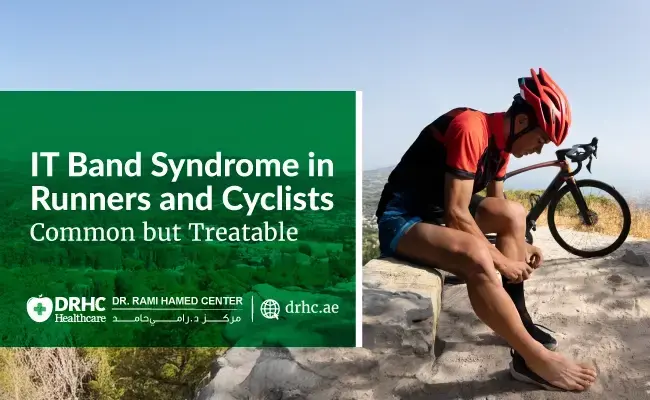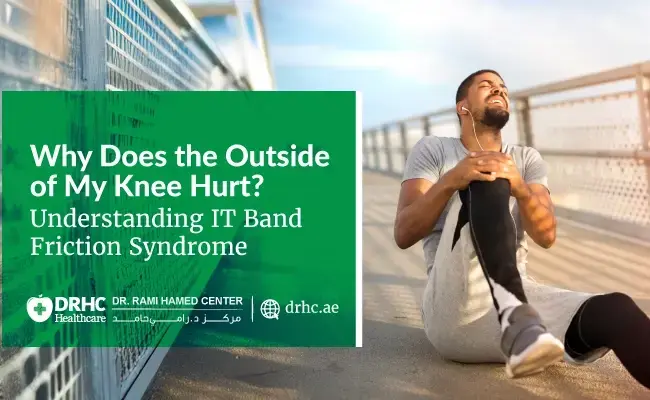
Iliotibial (IT) band syndrome can be a frustrating and painful condition, especially for active individuals, runners, cyclists, and those who spend long hours on their feet. If you've been battling persistent pain along the outside of your knee or thigh, it's natural to wonder—will I need surgery to get better?
At Dr. Rami Hamed Center (DRHC) in Dubai, believes in exploring all conservative treatment options first. Surgery is considered only when necessary. In this blog, we’ll walk you through when surgery may be required for IT band syndrome, what the procedure involves, and what you can expect during recovery.
What Is IT Band Syndrome?
The iliotibial band is a thick band of connective tissue that runs from the hip to the knee, helping to stabilize the leg during movement. IT band syndrome occurs when this band becomes tight or inflamed, usually due to overuse, poor biomechanics, or repetitive activities. It commonly causes:
- Pain on the outside of the knee (especially during running or descending stairs)
- Tenderness or tightness in the thigh
- Swelling or clicking sensations near the knee
When Should You Consider Surgery?
Most cases of IT band syndrome improve with non-surgical treatment such as physiotherapy, stretching, rest, and anti-inflammatory medications. However, surgery may be considered when:
- Symptoms persist for more than 6–12 months despite conservative treatment
- There’s no improvement with physical therapy or activity modification
- Daily life is affected, such as being unable to walk without pain
- Imaging (MRI or ultrasound) shows thickened or fibrotic IT band or bursal inflammation that doesn't resolve
At DRHC Dubai, surgery is only recommended after thorough evaluation and if your pain continues to limit your mobility and quality of life despite all non-invasive efforts.
What Does IT Band Surgery Involve?
If surgery becomes the best option, rest assured
If surgery becomes the best option, rest assured—it is typically a minimally invasive outpatient procedure. The most common approach is an IT band release or bursectomy, where:
- The thickened portion of the IT band is lengthened or released
- Inflamed tissue around the lateral femoral condyle (outer knee) is removed
- Sometimes, the bursa beneath the IT band is cleaned out
This surgery is done under local or general anesthesia, and most patients can go home the same day.
Our Related Blogs:
- How is Jumper's Knee Treated? Conservative to Surgical Options
- When Does Jumper's Knee Require Arthroscopic Surgery?
- Understanding Arthroscopic Surgery for Jumper's Knee: A Step-by-Step Guide
- What Happens During Arthroscopic Patellar Tendon Debridement?
- Why Choose Dr. Rami Hamed for Arthroscopic Knee Surgery in Dubai?
- What is Iliotibial Band Syndrome (ITBS)?-Causes and Symptoms
- Why Does the Outside of My Knee Hurt? Understanding IT Band Friction Syndrome
- IT Band Syndrome in Runners and Cyclists-Common but Treatable
Frequently Asked Questions (FAQs)
🩹 Is the surgery painful?
Discomfort after surgery is usually mild and manageable with prescribed pain medication. Many patients describe it as less painful than expected.
⏱️ What’s the recovery time?
Recovery typically takes 4–8 weeks, depending on your overall health and how well your tissues heal. Most patients return to normal walking within 1–2 weeks and resume sports activities within 6–8 weeks under guidance.
⚠️ Are there any risks?
As with any surgery, risks include infection, stiffness, or recurrence of symptoms. However, when performed by experienced orthopedic surgeons—as at DRHC Dubai—the risks are minimal, and outcomes are generally excellent.
🧘 Will physical therapy be needed after surgery?
Yes, rehabilitation is essential. Post-surgery physiotherapy focuses on stretching, strengthening, and correcting biomechanics to prevent recurrence and help you regain full function.
Are There Alternatives to Surgery?
Yes. Before moving to surgery, your care team at DRHC Dubai may try other therapies such as:
- Corticosteroid injections to reduce inflammation
- Platelet-rich plasma (PRP) therapy for tissue healing
- Custom orthotics or gait retraining if poor biomechanics are contributing to the problem
- Dry needling or deep tissue massage for muscle tightness
If these treatments do not relieve your symptoms after several months, surgical intervention may be the next logical step.
Compassionate Care at DRHC Dubai
We understand that the thought of surgery can be overwhelming. That’s why at DRHC Dubai, we take a patient-first approach, ensuring that you are fully informed, supported, and comfortable at every step—from diagnosis to recovery. Our orthopedic specialists work closely with physiotherapists and sports medicine professionals to tailor a treatment plan that’s right for you.
Conclusion: Getting Back to Pain-Free Movement
Surgery for IT band syndrome is rarely the first step—but it can be the right one when conservative care isn’t enough. If your knee pain is interfering with your lifestyle and not improving, don’t wait. A thorough evaluation can help determine if surgical treatment is necessary or if other options may still be effective.
For personalized care and expert consultation, book an appointment with the orthopedic team at Dr. Rami Hamed Center (DRHC) in Dubai. Your path to pain-free movement begins here.
Dr. Rami Hamed
Consultant Spine & Orthopedic Surgeon
Founder, DRHC – Dubai Healthcare City
📞 +971 4 279 8800
🌐 www.drhc.ae
📍 Dubai Healthcare City, Building 52
Topic: orthopedic Knee




.jpg)



Leave a comment